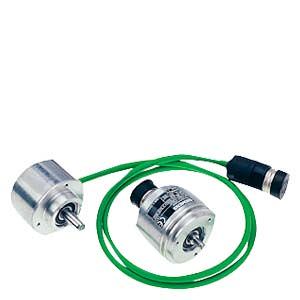Incremental encoders Siemens

Функции
Incremental encoders (sin/cos 1 Vpp/RS422) with cable and connector, andor Synchro flange
Incremental encoders deliver a defined number of electrical pulses per revolution, which represent the measurement of the traveled distance or angle.
Incremental encoders operate on the principle of optoelectronic scanning of dividing disks with the transmitted light principle. The light source is a light emitting diode (LED). The light-dark modulation generated as the encoder shaft rotates is picked up by photoelectronic elements. With an appropriate arrangement of the line pattern on the dividing disk connected to the shaft and the fixed aperture, the photoelectronic elements provide two trace signals A and B at 90° to one another, as well as a reference signal R. The encoder electronics amplify these signals and convert them into different output levels.
The following output levels are available:
- Analog signals sin/cos with 1 Vpp level
Better resolution can be achieved for encoders with sinusoidal signals by interpolating them in the higher-level controller. - RS422 difference signals (TTL)
In the case of RS422 incremental encoders (TTL), the resolution can be improved by a factor of four by means of edge evaluation.
Технические данные
Product name | Incremental encoder with sin/cos 1 Vpp | Incremental encoder with RS422 (TTL) |
| 6FX2001-3.... | 6FX2001-2.... |
Operating voltage Vp on encoder | 5 V DC ± 10 % | 5 V DC ± 10 % or 10 ... 30 V DC |
Limit frequency, typ. | ≥ 100 kHz (- 3 dB) | – |
Scanning frequency, max. | – | 300 kHz |
No-load current consumption, max. | 150 mA | 150 mA |
Signal level | Sinusoidal 1 Vpp | TTL (RS422) |
Outputs protected against short-circuit to 0 V | Yes | Yes |
Switching time (10 ... 90 %) | – | Rise/fall time |
Phase angle, signal A to B | 90° ± 10°el. | 90° |
| – | ≥ 0.45 µs |
Cable length to | 150 m (492 ft) | 100 m (328 ft) |
LED failure monitoring | – | High-resistance driver |
Resolution, max. | 2500 S/R | 5000 S/R |
Accuracy | ± 18 mech. × 3600/number of signals/revolution z | ± 18 mech. × 3600/number of signals/revolution z |
Speed, max. | ||
| (18 × 106 rpm)/number of signals/revolution (at - 6 dB) | (18 × 106 rpm)/number of signals/revolution |
| 12000 rpm | 12000 rpm |
Friction torque (at 20 °C (68 °F)) | ≤ 0.01 Nm (0.09 lbf‑in) | ≤ 0.01 Nm (0.09 lbf‑in) |
Starting torque (at 20 °C (68 °F)) | ≤ 0.01 Nm (0.09 lbf‑in) | ≤ 0.01 Nm (0.09 lbf‑in) |
Shaft loading capacity | ||
| ||
| 40 N (8.99 lbf) | 40 N (8.99 lbf) |
| 60 N (13.5 lbf) | 60 N (13.5 lbf) |
| ||
| 10 N (2.25 lbf) | 10 N (2.25 lbf) |
| 20 N (4.50 lbf) | 20 N (4.50 lbf) |
Shaft diameter | ||
| 6 mm (0.24 in) | 6 mm (0.24 in) |
| 10 mm (0.39 in) | 10 mm (0.39 in) |
Shaft length | ||
| 10 mm (0.39 in) | 10 mm (0.39 in) |
| 20 mm (0.79 in) | 20 mm (0.79 in) |
Angular acceleration, max. | 105 rad/s2 | 105 rad/s2 |
Moment of inertia of rotor | 1.45 × 10-6 kgm2 | 1.45 × 10-6 kgm2 |
Vibration (55 ... 2000 Hz) to EN 60068‑2‑6 | ≤ 300 m/s2 (984 ft/s2) | ≤ 300 m/s2 (984 ft/s2) |
Shock acc. to EN 60068‑2‑27 | ||
| ≤ 2000 m/s2 (6562 ft/s2) | ≤ 2000 m/s2 (6562 ft/s2) |
| ≤ 1000 m/s2 (3281 ft/s2) | ≤ 1000 m/s2 (3281 ft/s2) |
Degree of protection acc. to EN 60529 (IEC 60529) | ||
| IP67 | IP67 |
| IP64 | IP64 |
Ambient temperature | ||
Operation | ||
| ||
| -40 ... +100 °C (‑40 … +212 °F) | -40 ... +100 °C (‑40 … +212 °F) |
| – | -40 ... +70 °C (‑40 … +158 °F) |
| ||
| -10 ... +100 °C (+14 … +212 °F) | -10 ... +100 °C (+14 … +212 °F) |
| – | -10 ... +70 °C (+14 … +158 °F) |
Weight, approx. | 0.3 kg (0.66 lb) | 0.3 kg (0.66 lb) |
EMC | Tested in accordance with the guidelines for electromagnetic compatibility 89/336/EEC and the regulations of the EMC guidelines (generic standards) | Tested in accordance with the guidelines for electromagnetic compatibility 89/336/EEC and the regulations of the EMC guidelines (generic standards) |
Approvals, according to | CE, cULus | CE, cULus |
S/R = signals/revolution
1) With recommended cable and input circuitry of the downstream electronics, observe max. permissible cable length of module to be evaluated.







 Ответ от производителя может занять до 5 дней и более.
Ответ от производителя может занять до 5 дней и более.

